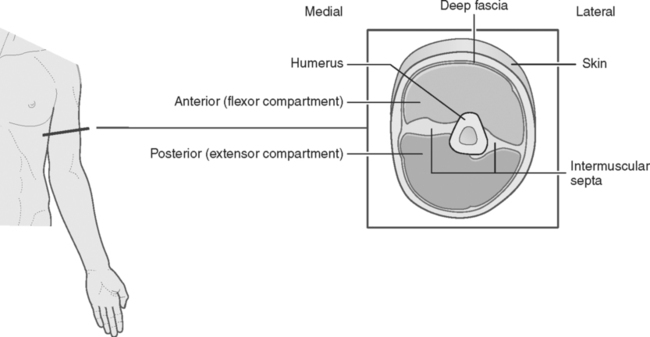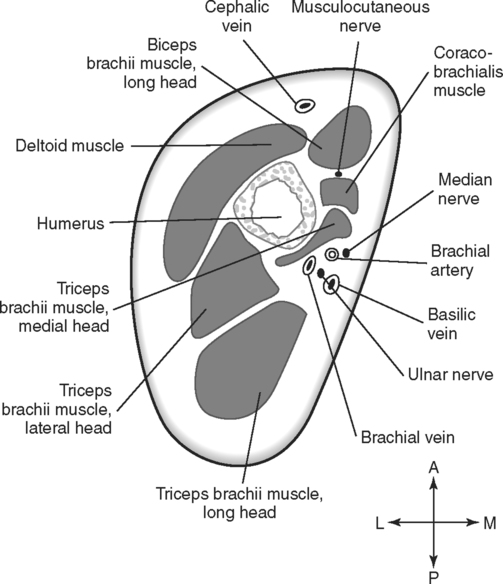Upon completion of this chapter, the student should be able to do the following: • Identify the bones that make up the pectoral girdle. • Describe the location and functions of three groups of muscles associated with the attachment of the pectoral girdle and the upper extremity to the trunk of the body. • Describe the boundaries and contents of the axilla. • Identify the skeletal, muscular, vascular, and neural components of the arm. • Describe the boundaries and contents of the cubital fossa and identify its components in a transverse section. • Identify the skeletal, muscular, vascular, and neural components of the forearm. • Name and locate the eight bones in the wrist and discuss the structure and significance of the carpal tunnel. • Identify the structural components of the arm in transverse sections through the proximal and distal regions. • Identify the structural components of the forearm in transverse sections through the proximal and distal regions. • Describe the structure of the shoulder joint and discuss the anatomical relationships of its components. • Identify structural components of the shoulder joint in transverse sections through the humeral head and the glenoid fossa, and in a coronal section. • Describe the structure of the elbow joint and discuss the anatomical relationships of its components, including the humeroulnar, humeroradial, and radioulnar articulations. • Identify the structural components of the elbow joint in sagittal sections through the humerus and the ulna, through the humerus and the radius, and in a transverse section through the radius and the ulna. The scapula and the clavicle make up the pectoral girdle, which provides the connection between the upper extremity and the axial skeleton. The bones of the pectoral girdle are shown in Fig. 7-1. Muscles anchor the upper extremity and the pectoral girdle to the trunk of the body. These muscles can be divided into three groups. A third group extends from the trunk to the humerus. This group, which includes the pectoralis major and the latissimus dorsi, adducts the arm. Table 7-1 summarizes the muscles associated with the trunk, the scapula, and the humerus. TABLE 7-1 Muscles Associated with Trunk, Scapula, and Humerus The space at the junction of the arm and the thorax, between the upper limb and the chest wall, is called the axilla The anterior wall of the axilla is formed by the pectoralis major muscle and the pectoralis minor muscle Predominant structures in the posterior wall are the scapula and the subscapularis muscle Medially, the axilla is delineated by the ribs, the intercostal muscles, and the serratus anterior muscle. The narrow lateral wall is formed by the head of the humerus; specifically, it is formed by the intertubercular (bicipital) groove, where the anterior and posterior walls converge. The long head of the biceps brachii muscle is located in the intertubercular groove. The short head of the biceps brachii muscle and the coracobrachialis muscle are closely associated in this same region. The boundaries of the axilla are illustrated in Fig. 7-2. The region from the shoulder to the elbow is the arm, or brachium. The only bone in this region is the humerus, which is the longest bone in the upper extremity. The features of the humerus are shown in Fig. 7-3. The muscles of the arm, or brachium, are arranged in anterior and posterior compartments, which are separated by an intermuscular septum of fascia (Fig. 7-4). The muscles of the arm are summarized in Table 7-2. TABLE 7-2 One, or possibly two, brachial veins accompany the brachial artery These deep veins ascend through the arm to continue as the axillary vein. In addition to the deep brachial vein, two important superficial veins are in the arm. The cephalic vein is in the superficial fascia, anterolateral to the biceps brachii muscle. As it courses superiorly, it passes between the deltoid and the pectoralis major muscles to empty into the axillary vein. The basilic vein is in the superficial fascia on the medial side of the arm. About one third of the way up the arm from the elbow, the basilic vein passes deep to the superficial fascia and continues upward to merge with the brachial vein to form the axillary vein. Both the superficial cephalic and basilic veins are frequently visible through the skin. Fig. 7-5 shows some of the vascular relationships in the arm.
The Upper Extremity
Anatomical Review of the Upper Extremity
Attachment of the Upper Extremity to the Trunk
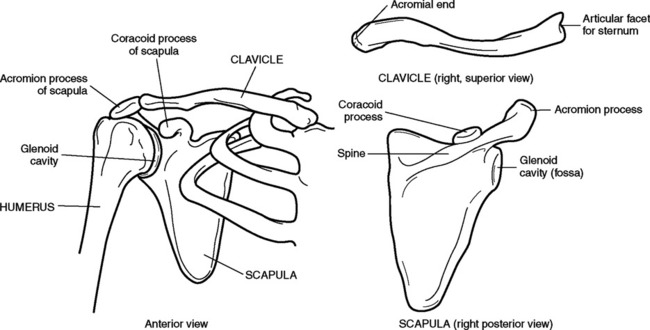
Muscle
Origin
Insertion
Action
Innervation
Extend from Trunk to Scapula
Trapezius
Thoracic vertebrae
Spine of scapula
Adduct scapula
Accessory (XI)
Rhomboids
Cervical and thoracic vertebrae
Medial border and spine of scapula
Adduct scapula
Dorsal scapular
Levator scapulae
Cervical vertebrae
Medial border of scapula
Elevate scapula
Dorsal scapular
Pectoralis minor
Third to fifth ribs
Coracoid process of scapula
Pull scapula inferiorly
Medial pectoral
Serratus anterior
First eight ribs
Medial border of scapula
Rotate scapula
Long thoracic nerve
Extend from Scapula to Humerus
Deltoid
Acromion and spine of scapula; clavicle
Deltoid tuberosity of humerus
Abduct arm
Axillary
Supraspinatus
Supraspinous fossa
Greater tubercle of humerus
Abduct arm
Suprascapular
Subscapularis
Subscapular fossa
Lesser tubercle of humerus
Medial rotation of arm
Subscapular
Infraspinatus
Infraspinous fossa
Greater tubercle of humerus
Lateral rotation of arm
Suprascapular
Teres minor
Lateral margin of scapula
Greater tubercle of humerus
Lateral rotation of arm
Axillary
Teres major
Superior lateral margin of scapula
Intertubercular groove of humerus
Adduct arm
Subscapular
Coracobrachialis
Coracoid process of scapula
Shaft of humerus
Adduct arm
Musculocutaneous
Extend from Trunk to Humerus
Pectoralis major
Clavicle, sternum, costal cartilages
Intertubercular groove of humerus
Adduct and medially rotate humerus
Medial and lateral pectoral
Latissimus dorsi
Thoracic and lumbar vertebrae; crest of ilium
Intertubercular groove of humerus
Adduct and medially rotate humerus
Thoracodorsal
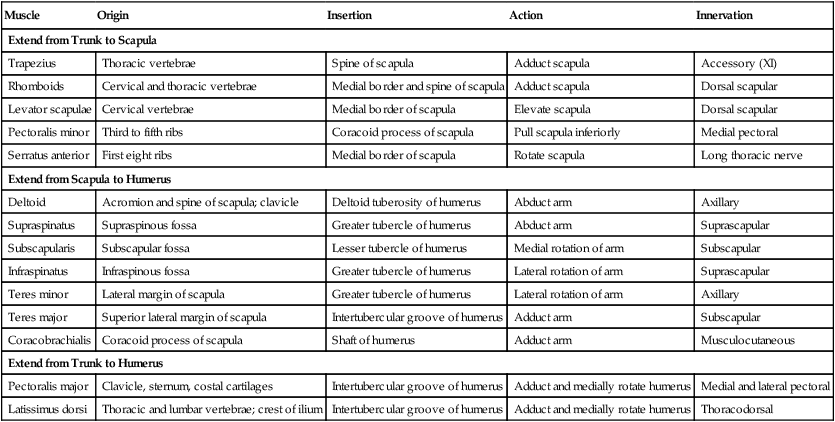
Axilla

General Anatomy of the Arm
Osseous Components.
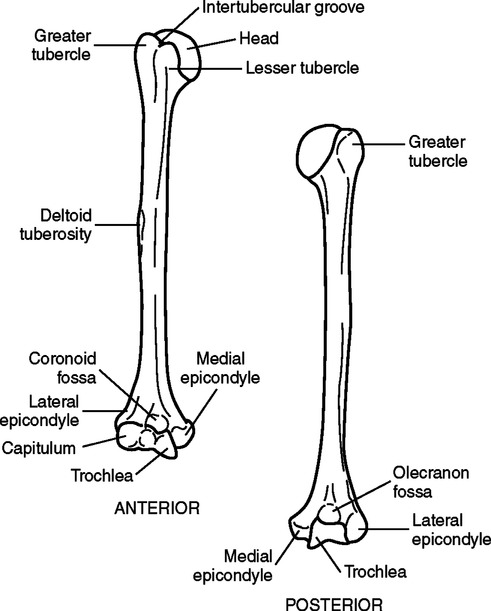
Muscular Components.
Muscle
Origin
Insertion
Action
Innervation
Anterior Compartment
Biceps brachii
Radius and ulna
Flex and supinate forearm
Musculocutaneous
Coracobrachialis
Coracoid process
Medial humerus
Flex and adduct shoulder
Musculocutaneous
Brachialis
Distal humerus
Ulna
Flex forearm
Musculocutaneous
Posterior Compartment
Triceps brachii
Olecranon process of ulna
Extend arm at elbow and stabilize shoulder
Radial

Vascular Components.
The Upper Extremity

